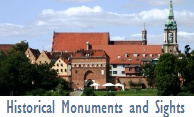|
Only three out of the twelve medieval gates in Toruń (eight in the Old City, four in the New City) have survived. Others were dismantled mainly in the second half of the 19th century, together with the majority of city walls. The surviving ones are situated along the Vistula. Two of all the gates were markedly broad and massive, which was a characteristic feature of the gates in Flanders. These included the non-preserved Paulinian Gate (Brama Paulińska) with a superstructure in the form of an octagon added in the first half of the 14th century and the surviving Monastic Gate (Brama Klasztorna) of the first half of the 14th century.
Demolishing other gates, including Chełmno Gate (Brama Chełmińska), was a great loss for Toruń.
 Holy Spirit Gate Holy Spirit Gate |
|
 Sailors Gate Sailors Gate |
|
 Bridge Gate Bridge Gate |
|
Polish: Brama Ducha Św.
Modelled on the gates built in Flanders, the broad and austere gate dating from the first half of the fourteenth century led to the port quay. It was named after the Benedictine nunnery, formerly located in this place and pulled down during the Swedish siege (17th century).
|
|
Polish: Brama Żeglarska
Dating from the first half of the fourteenth century, Sailor’s Gate was one of the most important gates in Toruń: it performed a representative function, among other things. Here, a ceremonial welcome was extended to the distinguished guests. Here, Toruń’s Royal Walk began, leading to the Old City Town Hall. |
|
Polish: Brama Mostowa
The third and last gate was erected in 1432 by Hans Gotland. It led to the non-extant bridge built under the privilege granted by King John I Albert in 1500. The bridge, from which the gate took its name, was the second longest stable bridge in the Kingdom of Poland after that of Krakow.
|
 Locations Locations: see the map above. The gates are signed with the green labels. Interior sightseeing: no sightseeing. The city authorities have decided not to make them available for tourists (for example the Bridge Gate houses Municipal Office for the Monuments Protection).
|
| Users' comments (8) | | 1/3 | choose sub-page: 1 2 3 from 3 |
| cityofloves, 2025-04-27 17:18:56 (152.58.159.65)
Our ESCORT Service In MUMBAI are very professional and cool nature in industry. We never miss a meeting and are extremely dedicated to our work. Our professional will always arrive on time. From the prices to the descriptions. From the photographs to the service list. Additionally, we supply accurate, high-quality profile images. It is important for clients to take advantage of the information displayed and pick the right Escort Service for them MUMBAI Escort will not look less than a model and are skillful.
https://www.cityofloves.com/
https://www.cityofloves.com/locations/escort-servi ce-in-mira-road/
https://www.cityofloves.com/locations/escort-servi ce-in-colaba/
https://www.cityoflo
| Bookmyjet, 2025-03-10 12:00:25 (106.219.122.51)
Book My Jet is the leading marketplace connecting Private Jet Operators with passengers and brokers worldwide. Our platform offers a comprehensive Air Charter Operators List, providing seamless access to top-tier services for luxury air travel. As the best platform for Air Charter Operators, we ensure efficient operations, maximum visibility, and smooth bookings. Partner with Book My Jet to elevate your charter business and reach a global clientele effortlessly.
Visit us - https://www.bookmyjet.co/aircraft-operator
| Mireya onfiya, 2025-02-09 11:36:56 (209.58.130.37)
my ex-boyfriend dumped me 7 months ago after I caught him of having an affair with someone else and insulting him. I want him back in my life but he refuse to have any contact with me. I was so confuse and don't know what to do, so I visited the INTERNET for help and I saw a testimony on how a spell caster help them to get their ex back so I contact the spell caster and explain my problems to him..... he cast a spell for me and assure me of 15 hours that my ex will return to me and to my greatest surprise the third day my peter came knocking on my door and beg for forgiveness. I am so happy that my love is back again and not only that, we are about to get married. Once again thank you Dr Oko
| | 1/3 | choose sub-page: 1 2 3 from 3 |
|
|
|
Curent local weather in Toruń  | temp. 7.3° C |
|























